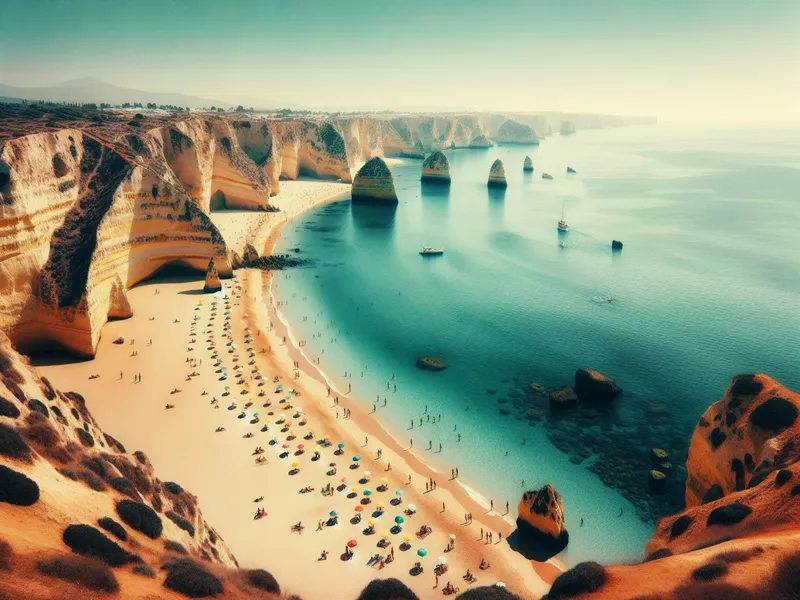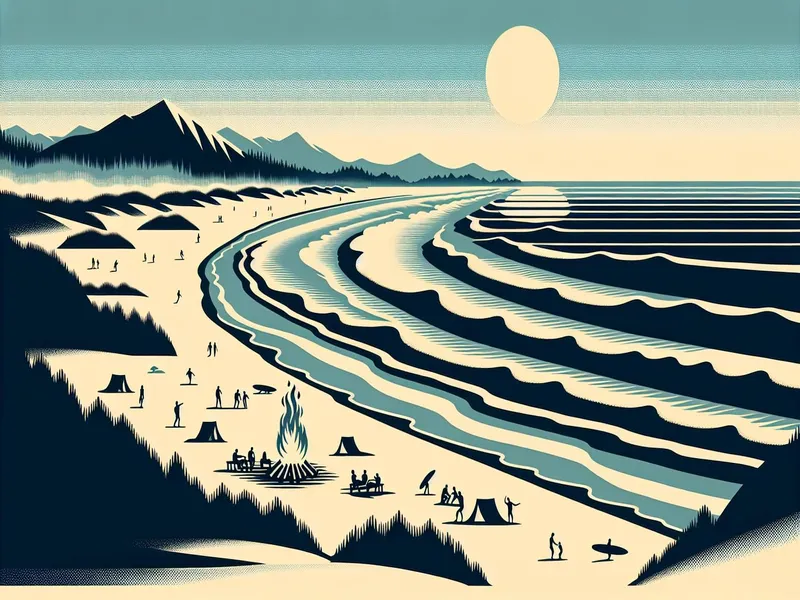
Whether you’re looking to relax on golden sands or jump into vibrant marine life, European beach destinations cater to every traveler’s desires.
Ignoring the allure of Europe’s beaches means missing out on a treasure trove of natural beauty and cultural richness. Imagine regretting not exploring hidden coves in Greece or skipping the lively beach scenes in Spain. The fear of lost opportunities can be a powerful motivator to start planning your next coastal adventure now.
Having spent years traveling through Europe’s breathtaking coastlines, I’ve discovered countless gems that offer both relaxation and excitement. From the French Riviera’s glamorous spots to Portugal’s rugged cliffs, my insights will guide you to the best seaside escapes.
Whether you’re an adventurous solo traveler or planning a family getaway, finding the perfect beach spot is crucial for making lasting memories. Each destination has its unique charm tailored to different preferences—be it tranquil hideaways or bustling beachfronts.
I understand how overwhelming trip planning can be, especially with so many options at hand. Trust me as your guide; together we’ll uncover Europe’s finest beaches and ensure your journey is nothing short of spectacular. For more ideas on exciting travel activities, check out this resourceful guide.
Top Beach Destinations in Europe
Europe’s coastline offers some of the world’s best beach experiences. Whether you’re seeking adventure or relaxation, here’s a rundown of the top beach destinations you can’t miss.
The Algarve, Portugal
The Algarve is a gem with its stunning cliffs and golden beaches. I remember my first visit to Praia da Marinha; it felt like stepping into a postcard. Highlights include:
- Praia da Marinha: Known for its crystal-clear waters and rock formations.
- Meia Praia: Perfect for long walks and water sports.
- Benagil Cave: Accessible only by boat or kayak.
Each spot has something unique—whether it’s secluded coves or bustling seaside towns. You’ll love exploring them all.
Costa Brava, Spain
Costa Brava offers vibrant beach scenes mixed with charming villages. I once spent an afternoon at Tossa de Mar; the medieval castle overlooking the sea was unforgettable.
Must-see spots:
- Tossa de Mar: Medieval charm meets turquoise waters.
- Lloret de Mar: Lively atmosphere with plenty of activities.
- Cadaqués: Artistic vibes inspired by Salvador Dalí.
The variety here keeps things interesting—you can enjoy everything from history to nightlife without leaving the coast.
Greek Islands
The Greek Islands are synonymous with paradise. My trip to Santorini’s Red Beach still stands out—the red volcanic sand against blue water is surreal.
Top picks:
- Santorini (Red Beach): Unique red sand and dramatic views.
- Mykonos (Paradise Beach): Famous for its party scene.
- Crete (Elafonissi Beach): Pink sands and shallow lagoons.
Each island has its own flair, offering diverse experiences that make every visit feel new.
Amalfi Coast, Italy
The Amalfi Coast oozes luxury and romance. Positano’s colorful houses cascading down cliffs into the azure sea is straight out of a dream—I felt like I’d walked into a movie set each time I visited.
- Positano: Iconic cliffside village with vibrant colors.
- Amalfi Town: Historical sites mixed with stunning beaches.
- Ravello: Terraced gardens offering panoramic coastal views.
It’s not just about sunbathing here; you’ll find culture, history, and jaw-dropping scenery at every turn.
Best Time for Beach Travel in Europe

Timing your beach trip to Europe can make all the difference. Depending on what you’re looking for, there’s a perfect season to match.
High Season
High season is from June to August when the sun shines bright and temperatures soar. Beaches are buzzing with life, so it’s ideal if you love crowds and socializing. Think of Greece’s Mykonos or Italy’s Amalfi Coast – packed but vibrant. I remember sipping cocktails at a beach bar in Ibiza; it was like being in a music video. Expect higher prices and crowded spots, though.
Shoulder Season
Shoulder seasons fall in May and September-October. These months offer warm weather without peak season chaos. It’s a sweet spot, especially for places like Portugal’s Algarve or Spain’s Costa Brava. One time in September, I explored Santorini’s Red Beach almost alone – pure magic! Prices drop, making it budget-friendlier while still enjoying pleasant temps.
Off-Season
Off-season spans from November to April when beaches are quiet but weather varies widely. If you’re into serene landscapes and don’t mind cooler days, this is your jam. Walking Positano’s empty streets felt like stepping back in time during winter months. Just pack layers because Mediterranean winters can be unpredictable – think more cozy walks than sunbathing.
Activities and Attractions

Exploring Europe’s beaches isn’t just about lounging on the sand. There’s a whole world of activities and attractions that make each destination unique.
Water Sports
When it comes to water sports, European beaches offer something for everyone. You can try windsurfing in Tarifa, Spain; it’s known as Europe’s wind capital. If you’re into diving, head to the Blue Hole in Gozo, Malta—crystal-clear waters and fascinating marine life await you there. For those who love surfing, Biarritz in France is the place to be with its powerful Atlantic waves.
Historical Sites
Beach trips aren’t all about the sea; history buffs will be thrilled too. Take Greece’s Navagio Beach for instance—it’s not just famous for its stunning blue waters but also for the shipwreck that’s been sitting there since 1980. Or think of Croatia’s Dubrovnik: after soaking up some sun on Banje Beach, you can wander through its ancient city walls dating back to the 10th century.
Local Cuisine
Food lovers won’t be disappointed either! Imagine savoring fresh seafood paella right by the beach in Valencia, Spain—the flavors are out of this world! If you find yourself on Italy’s Amalfi Coast, don’t miss out on trying limoncello made from locally grown lemons while enjoying breathtaking sunset views. And let’s not forget Portugal’s Algarve region where grilled sardines are a must-try—they’re simple yet incredibly delicious!
So whether you’re an adrenaline junkie or a history enthusiast, Europe’s beaches have got something special just for you.
Accommodation Options
When planning a beach getaway in Europe, where you stay can make or break your trip. Whether you’re splurging on luxury or keeping it low-key, there are options for every traveler.
Luxury Resorts
If you’re all about pampering and top-notch service, Europe has some stellar luxury resorts. Imagine waking up to the sound of waves crashing at Belmond Hotel Caruso in Italy’s Amalfi Coast. This place boasts infinity pools that seem to blend into the horizon. Or picture yourself lounging at The Chedi Lustica Bay in Montenegro with its modern architecture and private beach access. These resorts offer:
- Spa treatments
- Gourmet dining
- Exclusive beach access
They ensure you feel like royalty from check-in to check-out.
Budget-Friendly Stays
Not looking to empty your wallet? No worries! Europe offers plenty of budget-friendly accommodations without skimping on charm or comfort. Take Selina Porto in Portugal; it’s got a lively atmosphere with shared spaces perfect for meeting fellow travelers. Or consider Generator Hostel Barcelona, which combines affordability with style right near the beach.
Budget stays often include:
- Communal kitchens
- Free Wi-Fi
- Social events
These spots make it easy to have fun without very costly.
Unique Airbnb Experiences
For a truly memorable stay, why not try an Airbnb? You can find unique lodgings that add an extra layer of adventure to your trip. I once stayed in a refurbished windmill on Greece’s Mykonos Island – talk about Instagram-worthy! Another cool pick is a houseboat on Amsterdam’s canals if you’re visiting during off-beach season but still want a water vibe.
Unique Airbnbs often feature:
- Local decor
- Private amenities
- Personalized touches from hosts
These homes provide a cozy, authentic experience you’ll remember long after you’ve left the beach.
Travel Tips for Beach Vacations
Planning a beach vacation in Europe? I’ve got you covered with some essential tips to make your trip smooth and enjoyable. Let’s jump into the details.
Packing Essentials
Packing smart can make or break your beach trip. Start with lightweight clothing like shorts, t-shirts, and sundresses. Don’t forget a wide-brimmed hat and sunglasses to protect yourself from the sun. A good-quality sunscreen is non-negotiable; aim for SPF 30 or higher.
When it comes to footwear, pack both flip-flops for the sand and comfortable walking shoes for exploring nearby towns. If you’re planning water activities, consider bringing a pair of water shoes. Also, a compact yet absorbent microfiber towel can save space in your bag.
Here’s a quick list of must-haves:
- Lightweight clothing (shorts, sundresses)
- Wide-brimmed hat
- Sunglasses
- Sunscreen (SPF 30+)
- Flip-flops
- Comfortable walking shoes
- Water shoes
- Microfiber towel
Health and Safety
Your health and safety should always come first. In peak summer months, European beaches can get scorching hot, so it’s crucial to stay hydrated—bring along a reusable water bottle. I once skipped this step during my first trip to Spain’s Costa Brava and ended up feeling dizzy by midday!
If you’re swimming in unfamiliar waters, watch out for currents and heed any posted warnings about jellyfish or other marine life. It’s also wise to have a basic first aid kit on hand—band-aids, antiseptic wipes, and pain relievers cover most minor mishaps.
Remember these key points:
- Stay hydrated (reusable water bottle)
- Watch out for currents
- Heed warnings about marine life
- Carry a basic first aid kit (band-aids, antiseptic wipes)
Cultural Etiquette
Europe’s diverse cultures mean varied customs at each beach destination. For instance, top-free sunbathing is common on many French Riviera beaches but might not be as accepted elsewhere like in Portugal’s Algarve region.
Always check local regulations about beachwear before you go—it saves you from awkward situations! Many Mediterranean spots take siestas seriously; shops close midday which might catch you off guard if you’re used to constant availability back home.
Here are some etiquette tips:
- Check local regulations on beachwear
- Respect siesta times in Mediterranean regions
- Be mindful of personal space (some places prefer more distance)
Final Thoughts
Exploring Europe’s beaches offers an unparalleled blend of natural beauty, cultural richness, and unique experiences. Whether you’re drawn to the dramatic cliffs of Portugal’s Algarve or the romantic allure of Italy’s Amalfi Coast you’ll find a destination that fits your desires. From luxurious accommodations to budget-friendly stays each beach getaway can be tailored to your preferences.
I’ve shared my personal insights to help guide your journey so you can make the most of every moment. With proper planning and a sense of adventure, unforgettable memories await along Europe’s stunning coastlines.